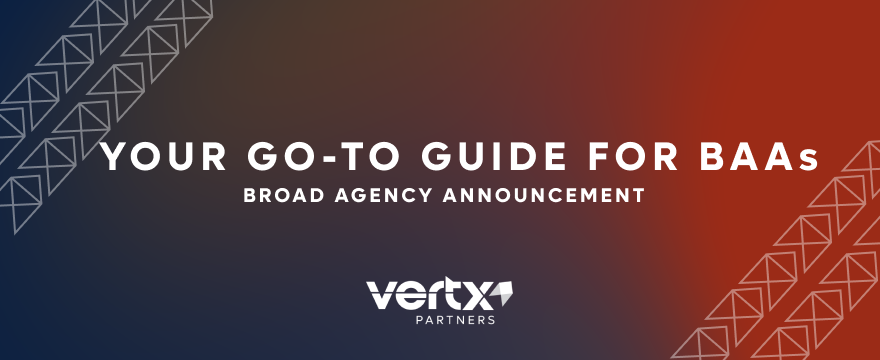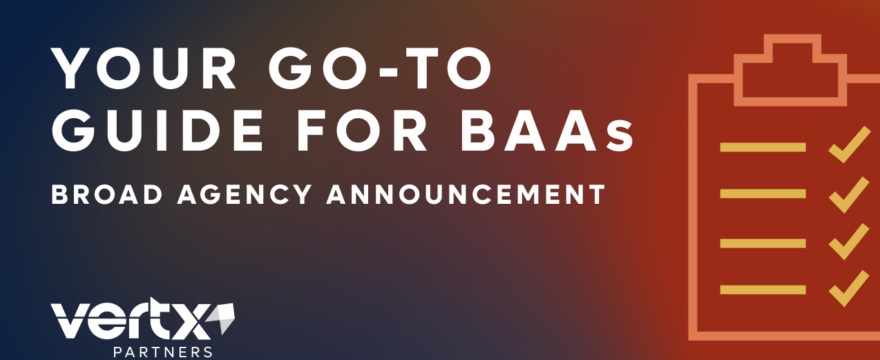How to read Broad Agency Announcements is an essential skill for prospective government contractors. Find out what BAAs offer and if they’re right for you.

The Federal Acquisition Regulation (FAR) has many tools to assist in acquiring and procuring supplies and services from private enterprises. Though the FAR was codified extensively and in great detail in the tome-like Title 48 of the Code of Federal Regulations (CFR), several of its tools allow leeway in soliciting services. One such tool is the Broad Agency Announcement (BAA). But how do you read Broad Agency Announcements and what even are they?
What is a Broad Agency Announcement?
A Broad Agency Announcement hints at its function in its title: it is an open – or ‘broad’ – call issued by a federal agency requesting proposals from private enterprises who claim to be able to answer that call. What does that call detail, exactly? BAAs typically solicit scientific or Research & Development (R&D) proposals related to a specific area of interest not tied to acquiring a particular system or technology.
Told another way, a BAA is an open challenge issued by the federal government: “If you think you can solve this theoretical issue we’re exploring, raise your hand.”
You may now see what we mean by the BAA allowing some latitude in the usually strict FAR handbook. These BAAs are essentially testing the waters in the earliest stages of a given program, so they are useful for:
- Basic and Applied Research
- Advanced Technology Development
- Advanced Component Development & Prototypes
This makes the BAA something of a blunderbuss, only used when the issuing agency has a good sense that its scattershot reach will garner at least some interest from a smattering of private enterprises. That means they can be hit-or-miss for perusing businesses, however. Still, they offer a broader approach to solving an issue than a Small Business Innovation Research (SBIR) or Small Business Technology Transfer (STTR) solicitation.
BAAs award funding in a variety of ranges from $100,000 to $20 million in the cases of consortium-sized entities. Award amounts are as varied as the solicitations themselves.
Who Issues Broad Agency Announcements?
To date, a wide array of government entities deploy BAAs, such as:
- Department of Defense (DoD) (Including the Dept. of the Air Force, Dept. of the Navy, Dept. of the Army, etc.)
- Department of Homeland Security
- Department of Commerce
- Department of Health and Human Services
- Department of the Interior
- Department of Transportation
- National Aeronautics and Space Administration (NASA)
Though SBIRs/STTRs and Other Transaction Agreements (OTAs) have displaced BAAs as the most popular form of government solicitation, they remain in use to this day.
What’s in a Broad Agency Announcement?
The contents of a BAA are detailed in FAR 35.016, stating that a BAA must:
- Describe the agency’s research interest, either for an individual program requirement or for broadly defined areas of interest covering the full range of the agency’s needs;
- Describe the criteria for selecting the proposals, their relative importance, and the method of evaluation;
- Specify the period during which proposals submitted in response to the BAA will be accepted; and
- Contain instructions for the preparation and submission of proposals.
So, the contents of a BAA are straightforward enough and follow logically from its purpose. But there isn’t just one type of BAA; they take different forms depending on their intended function.
What are the Different Types of Broad Agency Announcements?
BAAs take many forms. These forms are detailed within the individual BAA and are as follows:
- One-Step BAA: This is the standard form of BAA where a complete technical and cost proposal is requested from each solicitor. After review, the agency may choose all, part, or none of a solicitation.
- Two-Step BAA: This process deviates from the One-Step BAA when a large pool of offerors is expected. To save time on writing and reviewing, a white paper is requested from each solicitor for review. For those who pass the first step of review, a full proposal is expected per the evaluative criteria of the One-Step BAA.
- Open BAA: This approach allows for a white paper/proposal to be submitted anytime during a BAA’s lifetime.
- Closed BAA: Contrary to the Open BAA, this approach sets a strict due date for a white paper/proposal outlined in the BAA.
- Staggered-Closed BAA: Somewhere between an Open BAA and Closed BAA, this approach sets the deadline of the Closed BAA but isn’t as strict about its cut-off if some white papers/proposals are submitted afterward. However, these submissions are less likely to be chosen as they fall lower in the priority of review.
- BAA with Calls: This approach is a basic BAA that publishes broad information on its area of interest. However, the solicitation for white papers/proposals is transmitted via “Calls” that get published separately over the BAA’s lifetime.
Broad Agency Announcements are submitted regularly at SAM.gov, where businesses, academic institutions, and whole consortia are welcome to submit their proposals. There are almost 200 active BAAs listed on the site at the time of publication.
How Successful Solicitations Are Rewarded
All BAA proposals are subject to a peer/scientific review process, differing from typical FAR-based contract solicitations. If and when your business submits a successful solicitation based on the criteria that it is 1) technically feasible; 2) relevant to the BAA; and 3) available to be funded, then your award comes in the form of a Grant, Cooperative Agreement (CA), Technology Investment Agreement (TIA), or Other Transaction Agreement (OTA) to begin scientific/R&D efforts.
For our purposes, that’s the end of the BAA process for you and your enterprise! Depending on the type of award you are granted and the nature of your project, we could go into more detail, but the advice becomes more specialized at this stage; it’s best to speak directly with a Vertx representative if your BAA proposal is successful!
There are many factors to consider before pursuing a contract borne out of a Broad Agency Announcement, chief among them that your capabilities match the scientific/R&D needs of the given agency. Are you interested in working with the federal government to fund your research efforts? Contact Vertx Partners today and speak to an expert to get the best advice on moving forward.
Become an Innovator With Us
Tell us about yourself, answer a few questions, and hit submit. It’s as easy as that to get started.
